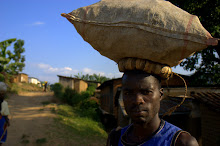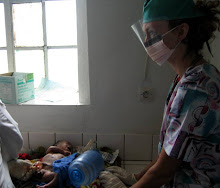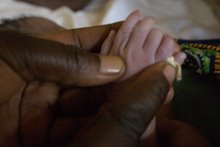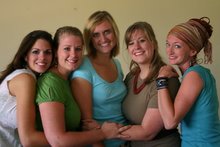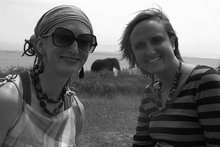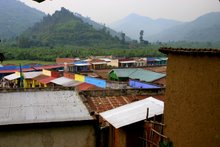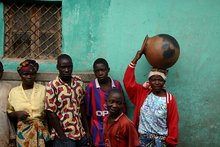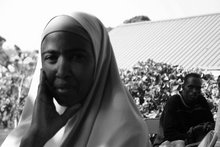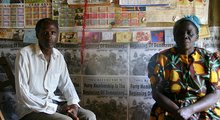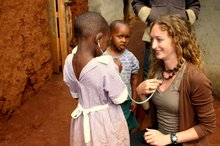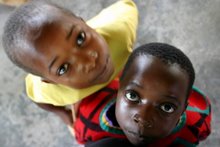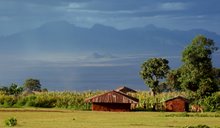 Many infants receive Oral Rehydration Solution (ORS) through a naso-gastic tube. ORS is a life-saver for children who can rapidly become dehydrated from diarrhea. It relies on Na-K pump in the GI tract which naturally absorbs the body’s requirements. In a third world setting without labs to measure electrolytes, this is more helpful than IVs requiring calculating electrolytes. It is also a fraction of the cost of IVs. The nasogastric tube ensures that the children get all they need even if the mothers can’t get them to drink it.
Many infants receive Oral Rehydration Solution (ORS) through a naso-gastic tube. ORS is a life-saver for children who can rapidly become dehydrated from diarrhea. It relies on Na-K pump in the GI tract which naturally absorbs the body’s requirements. In a third world setting without labs to measure electrolytes, this is more helpful than IVs requiring calculating electrolytes. It is also a fraction of the cost of IVs. The nasogastric tube ensures that the children get all they need even if the mothers can’t get them to drink it. When a child is admitted, part of the hospital chart reads: “Grattage” checked OUI or NON. Grattage is a local practice of scrapping or cutting the throat. This tradition is based on the medical practices for diphtheria. Diptheria causes a grayish coating on the throat. Before vaccinations were routine, the disease was common and treated by health workers who would scrape the coating off. I wonder if this tradition also applies the belief in some parts of Africa that cutting an area of pain will “bleed out” the pain.
When a child is admitted, part of the hospital chart reads: “Grattage” checked OUI or NON. Grattage is a local practice of scrapping or cutting the throat. This tradition is based on the medical practices for diphtheria. Diptheria causes a grayish coating on the throat. Before vaccinations were routine, the disease was common and treated by health workers who would scrape the coating off. I wonder if this tradition also applies the belief in some parts of Africa that cutting an area of pain will “bleed out” the pain.Now it is a problem because many children come to the hospital after their parents have (out of the best intentions) scrapped or cut the throat which can lead to infection. This child above had pneumonia and had his throat scraped. He is treated with Chloramphenicol. It is not used in the US much because of an extremely rare condition of aplastic anemia (although unlikely, just one case could ruin a career in the states with legal suits). In Africa it is utilized because the chance of aplastic anemia is less than the chance of ototoxicity or renal damage (which in not monitored as carefully here) by the other options: Gentamycin and Ampicillin. Also, cost is always an issue. One drug, Chloramphenicol, is less costly than using the combination of Gent and Amp.
 Clarice Musawimana is 7 years old, but her 4 year-old brother has outgrown her. Along with the growth retardation her mother said she has had a chronic cough since she was 1 y.o. Through all the exams I only heard her cough once. At first we were worried about her heart. An echo showed that it could possibly be enlarged, but the interpretation is very subjective. She had no murmurs, rubs, or gallops, just a physiologic split with inspiration. After a day trip to the nearest town we had an X ray that showed a normal heart size. The X ray showed somewhat prominent hilar markings, but otherwise normal. Her lung sounds were clear on auscultation. Eventually we ruled out lung pathology. We worried about HIV, but she tested negative. TB was part of the diagnosis because of the delay in growth and cough. Her PPD was negative, and her three sputum collections showed no Acid-Fast Bacilli.
Clarice Musawimana is 7 years old, but her 4 year-old brother has outgrown her. Along with the growth retardation her mother said she has had a chronic cough since she was 1 y.o. Through all the exams I only heard her cough once. At first we were worried about her heart. An echo showed that it could possibly be enlarged, but the interpretation is very subjective. She had no murmurs, rubs, or gallops, just a physiologic split with inspiration. After a day trip to the nearest town we had an X ray that showed a normal heart size. The X ray showed somewhat prominent hilar markings, but otherwise normal. Her lung sounds were clear on auscultation. Eventually we ruled out lung pathology. We worried about HIV, but she tested negative. TB was part of the diagnosis because of the delay in growth and cough. Her PPD was negative, and her three sputum collections showed no Acid-Fast Bacilli.We moved on to other possibilities of growth retardation. Malaria is always on the differential here, and recurrent bouts could possibly cause growth delay. But her blood smear showed no malaria. An abnormal presentation of Cystic Fibrosis? No other symptoms were present, and there is no cure anyways especially in Africa. We brainstormed hematological causes and malnutrition, but nothing matched the history and symptoms. She came in with a slightly distended abdomen, so we treated for worms; and, after a week in the hospital waiting for tests, she was released with the worm drug that costs pennies. We concluded that some families have small and large children. Maybe she’s the oldest yet smallest and worms delayed her even more.
I loved this case. It was a privilege to work with Dr. Theoneste and Dr. King on it. Her case was such a great example of African medicine: always operating under a wide differential while you wait and wait for tests. Many tests are extremely costly and distant, so you must decide what you will do with the findings. TB, HIV, malaria, malnutrition, and parasites are always in the back of your mind—to treat, to rule out, or to finally accept as a most likely diagnosis.
 This was a particularly tragic case to me. Maurice Maniragaba was a 14 y.o. boy. His family noticed his eyes were yellow in February. In May his body became swollen. He had some convulsions and was hospitalized in another district for three days. He came to Shyira in a coma and liver failure. His head was swollen from hepatic encephalopathy. His belly was swollen from ascities. His blood glucose was 25 mg/dL and I could smell ammonia as he breathed.
This was a particularly tragic case to me. Maurice Maniragaba was a 14 y.o. boy. His family noticed his eyes were yellow in February. In May his body became swollen. He had some convulsions and was hospitalized in another district for three days. He came to Shyira in a coma and liver failure. His head was swollen from hepatic encephalopathy. His belly was swollen from ascities. His blood glucose was 25 mg/dL and I could smell ammonia as he breathed.Most likely, he had an acute hepatitis that made his eyes jaundiced in February. After his release from the hospital his parents used local herbal remedies that are less expensive than medical care. We assume that these local herbs were toxic to his already damaged liver. I drained some fluid from his belly for testing and Dr. Theoneste did a lumbar puncture to make sure the coma was not from another infectious source. I did not see the results because he died before the morning.
 This child is 15. His thin frame makes it unbelievable though. A basic test for malnutrition is arm circumference: your fingers should not be able to touch. He is an orphan. He has no farm or land to live on. His parent’s plot may have been taken over in the conflict after their death. He has been hanging around the hospital more since people are helping to take care of him.
This child is 15. His thin frame makes it unbelievable though. A basic test for malnutrition is arm circumference: your fingers should not be able to touch. He is an orphan. He has no farm or land to live on. His parent’s plot may have been taken over in the conflict after their death. He has been hanging around the hospital more since people are helping to take care of him.




























